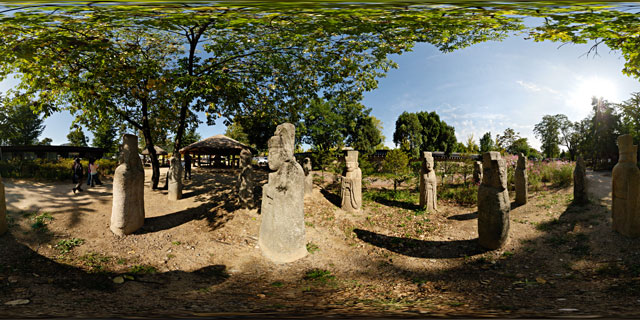
Click button below to view 360° VR interactive panorama
SD Standard definition suitable for users with slow internet connections or mobile devices or HD High definition suitable for users with fast internet connections
360° VR panorama of the stone statues of Civil officials, known as Muninseok (문인석), on display in the grounds of the National Folk Museum of Korea (국립민속박물관). The National Folk Museum of Korea is located in the grounds of Gyeongbokgung Palace (경복궁), Seoul (서울).
The aim of the National Folk Museum of Korea is to preserve the legacy of traditional Korean life and to educate on how Koreans lived in traditional times. The Museum is a popular attraction, receiving over two million visitors annually.

Click button below to view 360° VR interactive panorama
SD Standard definition suitable for users with slow internet connections or mobile devices or HD High definition suitable for users with fast internet connections
360° VR panorama of the ceremonial stone mound and Jangseung (장승) spirit posts outside the National Folk Museum of Korea (국립민속박물관) in Gyeongbokgung Palace (경복궁), Seoul (서울).
The Jangseung is a wooden pole (though sometimes made of stone) with a face carved near the top. They would normally be placed near the edges of villages to mark the village boundary and frighten evil spirits away from the village. Villagers would also pray to them to prevent calamity and bring a bountiful harvest.


Click button below to view 360° VR interactive panorama
SD Standard definition suitable for users with slow internet connections or mobile devices or HD High definition suitable for users with fast internet connections
360° VR panorama of the National Folk Museum of Korea (국립민속박물관). It is situated on the grounds of the Gyeongbokgung (Gyeongbok Palace) in Jongno-gu, Seoul, and uses replicas of historical objects to illustrate the folk history of the Korean people.
The museum was established as the Korean Folk Crafts Museum in 1924 by the Japanese philosopher Yanagi Sōetsu. That name was changed afterwards by the U.S. Government. on November 8, 1945. The museum has three exhibition halls which illustrate ‘The History of the Korean People’ from pre-historic times to the end of the Joseon Dynasty in 1910, ‘The Lifestyle of the Korean People’, and ‘The Lifecycle of a Korean from Birth to Death’. It also houses a children’s museum and an outdoor exhibition.
The museum was originally sited on Mt Namsan, and moved to Gyeongbokgung in 1975. The current building was built in 1972 and housed the National Museum of Korea until 1986. It was remodelled, and reopened as the National Folk Museum in 1993. The building’s design is based on various historical buildings around South Korea.
Above description adapted from National Folk Museum of Korea Wikipedia article.





